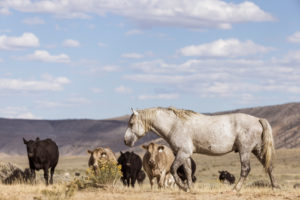The South Idaho Press has published a two part story involving the state of Idaho’s reaction to domestic sheep transmitting a deadly pneumonia to bighorn sheep when domestic sheep are allowed to graze on federal public land for a minuscule 27 cents per month.
More illustrating context about domestic sheep producer’s line to the governor including the domestic sheep producer’s letter requesting removal of Big Cottonwood Creek bighorn and an agency email demonstrating this sheep producer’s already denuding effect on deer hunting opportunity below :
Despite a Domestic sheep / Bighorn Sheep Working Group taking place to work out a state policy among stakeholders for ensuring space between sheep, domestic sheep producers have decided to take the issue into their own hands, compelling the Cassia County Commission to ask that 15 remaining bighorn in Big Cottonwood Creek, among the South Hills, be removed.
Domestic sheep producers have maintained that despite the overwhelming recommendations of a multi-disciplinary team of experts to keep the wild and domestic sheep apart, contact between domestic sheep and bighorn sheep has not been shown to definitively prove bighorn die-out following exposure between the domestic and bighorn sheep.
Producers suggest instead that it is stress that induces bighorn die-off, but as the following letter demonstrates, domestic sheep producers are asking for bighorn to be removed by the state ~ a stressful endeavor, thus deadly by their own admission ~ to maintain control over federal public land that garners them feed at the shamefully below-market rate of 27 cents per animal per month.
The letter also demonstrates the suggestion that the Idaho Department of Fish & Game and Western Watersheds Project are in cahoots ~ reacting to a letter (posted following the letter to Governor) formally documenting the complaints of mule deer hunters who were moved to report the disgraceful condition of your public land, which they along with IDF&G believed implicated their hunt, following domestic sheep grazing in the area :
RECEIVED:
DEC 27 2007
OFFICE OF THE GOVERNOR
RE: IDAHO DEPARTMENT OF FISH & GAME VRS. [PUBLIC LAND DOMESTIC SHEEP PRODUCER]
Dear Governor Otter:Thank you for your time and concern last Friday at our meeting regarding the bighorn sheep issue. Our family is in need of help that we think only you may be willing and able to provide. We have run sheep in Cassia County for over 100 years, and we are now told that the only feasible way to assure that we can turn out on public lands this grazing season is to relocate the few bighorns that are apparently in the lower Third Fork, Cave Canyon and Birch Creek areas of this county, at least until the science is given time to show that domestic sheep and bighorns can co-exist. As mentioned at our meeting, the science may may ultimately show that all or nearly all bighorns have Pasteurella pneumonia virus, but that this virus causes death in bighorns as a consequence of stress–not contact with domestic sheep. I am writing to request that these few bighorns be relocated while the science has time to develop.
We are growing wary of the inconsistent responses of the State of Idaho towards livestock grazing on public lands. It concerns us when we learn of efforts by Idaho Department of Fish and Game (IDF&G) officials to limit our grazing on federal lands (such as the enclosed email communication from [IDF&G] to [USFS District Ranger], which concludes with no basis other than the opinion of some unknown deer hunters that our livestock are adversely impacting mule deer hunting due to overgrazing and extending our season of use when in fact our grazing permit does not expire until November 14), particularly when we are told by our federal range conservationists that we keep our federal range in good condition.
We cannot fully utilize our state lease without our federal grazing permits. While we appreciate the help of Idaho Department of Lands in allowing us to retain our State Grazing Lease No. [omitted] following a hard fought battle with Western Watersheds Project, we are concerned that our [$$ ommitted] bid cannot be fully realized unless the IDF&G is willing to (1) avoid contesting our established federal grazing privileges through derogatory communications to our USFS and BLM officials and personnel, and (2) relocate the bighorns to an area such as Jim Sage. Given the tenor of the enclosed letter dated December 12, 2007 from Western Watersheds Project to [Forest Service] it is consistent with our experience to believe that IDF&G may be communicating with Western Watersheds Project with the concerted desire and/or intent of having our sheep removed from all or part of our federal lands, although such motivation may be difficult or impossible to prove.
Please help us maintain our sheep operation by facilitating whatever process is necessary to relocate these few head of bighorns across the valley to some other location such as the Jim Sage or Albion area.
Very truly yours,
[domestic sheep co.]
The documentation sent by IDF&G to Forest Service referenced by domestic sheep man in letter to governor.
[Forest Service employee],
We’ve received several calls from hunters today regarding bands of sheep grazing in upper Trout Creek (west side of drainage) and the Walstrom Hollows area. All callers have commented that it appears use is excessive – especially in riparian areas.
Talking with our staff, we were under the impression that livestock were suppose to be removed from that area by early October. This is impacting mule deer hunting and it’s an issue we need to discuss prior to next season.
Thanks for your consideration,
[IDF&G employee]






